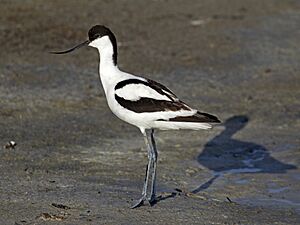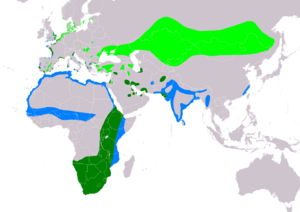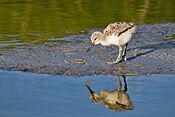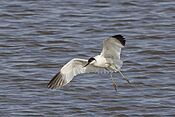Pied avocet facts for kids
Quick facts for kids Pied avocet |
|
|---|---|
 |
|
| Conservation status | |
| Scientific classification | |
 |
|
| Range of R. avosetta
Breeding Resident Non-breeding |
The pied avocet (Recurvirostra avosetta) is a beautiful black and white wader bird. It belongs to the avocet and stilt family, called Recurvirostridae. These birds live in many parts of Europe and Asia.
Pied avocets are migratory birds. This means they travel long distances. Most of them spend their winters in Africa or southern Asia. Some stay in warmer areas like southern Spain or southern England. The pied avocet is an important bird. It is protected by an agreement called AEWA. This agreement helps protect many migratory waterbirds.
Contents
About the Pied Avocet's Name
The pied avocet was first described by Carl Linnaeus in 1758. He was a famous scientist. He gave it the scientific name Recurvirostra avosetta.
The name avosetta comes from a word in the Venetian language. It first appeared in a book about birds in 1603. Some people think the name might relate to the black and white clothes worn by old European lawyers. But no one is completely sure where the name came from. Other common names for this bird are black-capped avocet or Eurasian avocet.
The avocet is one of four types of birds in the Recurvirostra group. The name Recurvirostra comes from Latin words. Recurvus means "curved backwards" and rostrum means "bill." This describes their unique bill shape.
What Pied Avocets Look Like
The pied avocet is a striking white bird. It has bold black markings. Adult birds have mostly white feathers. They have a black cap on their head. They also have black patches on their wings and back.
These birds have long, thin, bluish legs. Their bill is long and curves upwards. An adult avocet is about 42 to 45 centimeters (16.5 to 17.75 inches) long. Their bill is about 7.5 to 8.5 centimeters (2.95 to 3.35 inches) long. Their legs are about 7.5 to 10 centimeters (3 to 4 inches) long. Their wingspan can be up to 80 centimeters (31.5 inches).
Male and female avocets look very similar. Young avocets look like adults. But their colors are more grayish and brown. The avocet's call sounds like a clear, musical "kluit kluit." You can hear it from far away.
Pied Avocet Behaviour
Pied avocets look for food in shallow, salty water. They also feed on muddy areas. They have a special way of eating. They swing their bills from side to side in the water. This helps them catch small crustaceans and insects. This feeding style is unique to avocets.
Reproduction and Habitat
Pied avocets breed in places with shallow, salty lakes. They also like open, muddy ground. They often build their nests on open ground. They usually nest in small groups. Sometimes, they nest with other wader birds.
They lay three to five eggs. The eggs are placed in a small hollow in the ground. This hollow is often lined with plants. Sometimes, they build a small mound of plants for their nest.
Pied Avocets in Britain
The pied avocet disappeared from Britain as a breeding bird by 1840. But it made a successful return. In 1947, they started breeding again at RSPB Minsmere in Suffolk. This return was so important that the Royal Society for the Protection of Birds chose the avocet as their logo.
Since then, the pied avocet has spread across Britain. They have moved inland and to the north and west. In 2018, they even bred in Wales and Scotland. Avocets have also been seen spending winter in places like Browhouses.
Gallery
-
Unlike other waders, the pied avocet has webbed foot, and can swim well.










